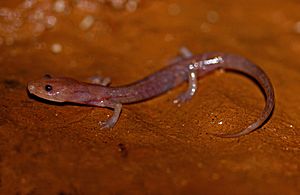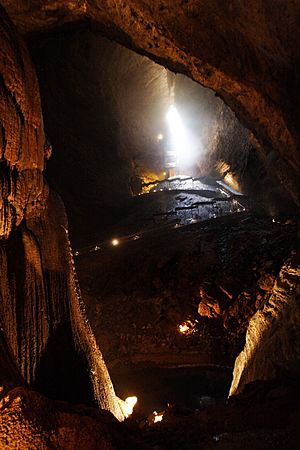Grotto salamander facts for kids
Quick facts for kids Grotto salamander |
|
|---|---|
 |
|
| Conservation status | |
| Scientific classification | |
| Synonyms | |
The grotto salamander (Eurycea spelaea) is a special type of salamander. It is also known as the Ozark blind salamander. These amazing creatures belong to the family Plethodontidae.
They are found only in the Ozark Mountains of the United States. This area includes parts of Arkansas, Kansas, Missouri, and Oklahoma. Grotto salamanders live in springs, underground karst areas, and caves.
Scientists first discovered the grotto salamander in 1891. Leonhard Hess Stejneger officially described it in 1892. The Ozark Plateau is still the only place where these salamanders have been found. While not currently endangered, their homes can be affected by changes in groundwater quality. A drop in bat populations can also harm them.
Life Stages of the Grotto Salamander
Grotto salamanders change a lot as they grow. This process is called metamorphosis. They are the only cave salamanders that go through such a big change.
When they are young, they are called larvae. These larvae look quite colorful. They are usually brownish or purplish gray. Sometimes, they have yellow spots on their sides. Larvae have a tall tail fin and special parts called external gills. These gills help them breathe underwater.
Young grotto salamanders also have working eyes. They can live outside of caves in small brooks or streams. Larvae are usually between 10 and 30 millimeters long.
After two or three years, the larvae begin to change. They lose their gills and their eyelids close up. This means the adult salamander becomes blind. The adult grotto salamander is pinkish white. It might have hints of orange on its tail, feet, and sides. Adults can grow up to 13.5 centimeters long. They have 16 to 19 grooves along their sides.
Where Do Grotto Salamanders Live?

Grotto salamanders live in caves and caverns throughout the Ozarks. They have been found in many different locations. There are at least 120 known sites in Arkansas. Oklahoma has 43 sites, and Missouri has 25.
As larvae, they live in springs and streams. These waterways are often close to cave entrances. Once they become adults, they move deeper inside the caves. They spend the rest of their lives living underground.
These salamanders prefer water temperatures between 5.5 and 16.5 degrees Celsius. They eat small creatures that live in caves. Their diet includes tiny invertebrates like Gammarus. They are also known to eat guano, which is bat droppings.


